THE WORLD BIRDS - An Online Bird Book
GRUIFORMES
Family Gruidae: Cranes
GRUIFORMES
Gruiformes means "crane-like", The order include 14 species of large cranes, about 145 species of smaller crakes and rails, as well as a variety of families comprising a small number of species.
Guiformes has the following families
Guiformes has the following families
Family Gruidae: Cranes
Cranes are large, long-legged and long-necked birds . Unlike the similar-looking but unrelated herons, cranes fly with necks outstretched, not pulled back. Cranes are widespread across the planet with two exceptions. It is not surprising not to find any cranes in Antarctica. However, there are also none in South America. Perhaps there were cranes there at one time and they became extinct.
Wetlands are a favorite habitat of cranes. In fact, all except the Sarus crane spend some time in wetlands during the breeding season. The crane’s wetland diet consists of mollusks, fish, amphibians, and emergent plants. On land they will eat insects, nuts, fruit, berries, worms, small animals, and bird eggs. They will dig for food such as tubers and slowly stalk prey such as frogs.
If a crane pair successfully raises young, they tend to stay together year after year. If they are unsuccessful breeds or a mate dies, then they will seek another mate. During the breeding season the cranes are not social, but instead the male will defend their territory. He will often use that same area for years and years. Outside of breeding times, the cranes are sociable. They will roots together in large numbers and some species will also feed together.
Genus Anthropoides
This genus contains the Blue Crane and Demoiselle Crane. They are birds of the dry, grassy uplands which feed on seeds and insects and spend little time in wetlands.
Crane,_Blue also Stanley Crane Anthropoides paradisea
Description: The blue crane has pale blue-gray plumage, with a light gray to whitish crown and face. Its gray bill has a pink tinge. It has a large, angular head.
Range: Africa.
Habitat: Grasslands, hills, valleys, plains, and pasturelands, typically near wetlands, especially during the breeding season.
Conservation status: Blue cranes are vulnerable due to habitat destruction, indiscriminate persecution, and indirect poisoning.
Image by: 1, 2) Dick Daniels - Birds of Eden, South Africa
43) Dick - San Diego Zoo 4) Sandy Cole - Tenikwa, South Africa Range: Africa.
Habitat: Grasslands, hills, valleys, plains, and pasturelands, typically near wetlands, especially during the breeding season.
Conservation status: Blue cranes are vulnerable due to habitat destruction, indiscriminate persecution, and indirect poisoning.




Crane,_Demoiselle Anthropoides virgo
Description: The Demoiselle crane has a blue-gray body and a blackish-gray head and neck with long white plumes extending from the eyes to the back of the head down the nape.
Range: Asia and Africa.
Habitat: Drier habitats such as desert, steppe, open fields, and plains usually near water, especially in the breeding season.
Conservation status: Least concern.
Image by: 1) Sandy Cole - Sylvan Heights 2, 3) Dick Daniels - Sylvan Heights 6)
Dick - San Diego Zoo Range: Asia and Africa.
Habitat: Drier habitats such as desert, steppe, open fields, and plains usually near water, especially in the breeding season.
Conservation status: Least concern.

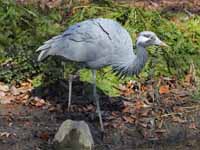
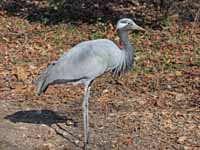

Genus Balearica
The crowned cranes are the only cranes that can roost in trees,
Crane,_Black_Crowned Balearica pavonina
Description: The black-crowned crane has mostly black plumage, red cheeks, a black forehead, and its characteristic golden crown. Its wings are mainly white with black primary flight feathers and purplish-brown secondaries. It is similar to the gray-crowned crane, but the latter has mostly gray plumage and white cheeks.
Range: Africa.
Habitat: Shallow wetlands, grasslands, marshes, river edges, and lakesides.
Conservation status: Vulnerable due to wetland degradation.
Image by: 1) M_Kuhn 2) Fabienkhan 3) Andy 4) Steve_Garvie - GambiaRange: Africa.
Habitat: Shallow wetlands, grasslands, marshes, river edges, and lakesides.
Conservation status: Vulnerable due to wetland degradation.




Crane,_Gray Crowned- Balearica regulorum
Description: The gray-crowned crane has mostly gray plumage, white cheeks, a black forehead, a red gular sac, and a characteristic golden crown. Its wings are mainly white with black primary flight feathers and purplish-brown secondaries. It is similar to the black-crowned crane, but the latter has mainly black plumage and red cheeks.
Range: Africa.
Habitat: Marshes, grasslands, agricultural lands.
Conservation status: The gray crowned crane is endangered due to habitat destruction and indirect poisoning.
Image by: 1) Dick Daniels - Tanzania 2) Dick - Jacksonville Zoo - Florida 3) Dick - Flamingos Wildlife Preserve 4) Charles_J_Sharp - Uganda Range: Africa.
Habitat: Marshes, grasslands, agricultural lands.
Conservation status: The gray crowned crane is endangered due to habitat destruction and indirect poisoning.

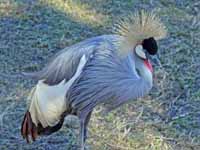


Genus Bugeranus -1 species
Crane,_Wattled Bugeranus carunculatus
Description: The wattled crane has a gray back, wings, and crown, a white lower head, neck, wattles, and upper breast, and red facial skin.
Range: Africa.
Habitat: Dense wetlands and marshes.
Conservation status: Wattled cranes are vulnerable due to habitat destruction, collision with powerlines, and human disturbances.
Image by: 1) Dick Daniels - National Zoo in Washington, DC 2, 3) Dick - Jacksonville Zoo, Florida 4) Adam_DewanRange: Africa.
Habitat: Dense wetlands and marshes.
Conservation status: Wattled cranes are vulnerable due to habitat destruction, collision with powerlines, and human disturbances.




Genus Grus
Brogla Grus rubicunda
Description: The brolga has mainly gray plumage, a bare gray-green crown, a red face and throat pouch, gray ear coverts, a grayish-green bill, yellowish-orange eyes, and grayish-black legs. It is similar to the sarus crane, but the latter has a red upper neck.
Range: Australia.
Habitat: Wetlands, floodplains, grasslands, marshes, shallow lakes, pasturelands, croplands, and wet meadows.
Conservation status: Least concern.
Image by:
1) Jjron - Healesville,
Victoria, Australia 2) David Cook - Beerwah, Queensland, Australia 3, 4) I Am birdsaspoetryRange: Australia.
Habitat: Wetlands, floodplains, grasslands, marshes, shallow lakes, pasturelands, croplands, and wet meadows.
Conservation status: Least concern.
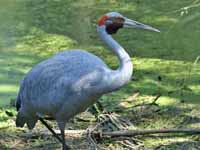
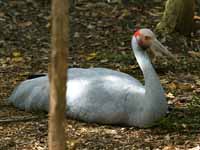


Crane,_Black-necked Grus nigricollis
Description: The black-necked crane has mainly gray plumage with a black head and neck and a black tail. It is similar to the common crane, but the latter has a gray and black neck and a gray tail.
Range: Asia.
Habitat: Alpine meadows, riverine marshes, river valleys, lakesides, and agricultural fields.
Conservation status: The black-necked crane is near-threatened, mainly due to habitat destruction.
Image by: 1) Eric Kilby - Stone Zoo 2) Eric Savage - Bronx Zoo 3) Dave_Curtis - China 4) Ed Gaillard - Bronx Zoo Range: Asia.
Habitat: Alpine meadows, riverine marshes, river valleys, lakesides, and agricultural fields.
Conservation status: The black-necked crane is near-threatened, mainly due to habitat destruction.
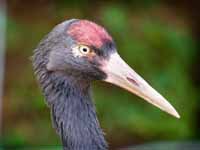



Crane,_Common also Eurasian Crane Grus grus
Description: The common crane has mainly gray plumage, darkest on the rump, and paler on the breast and wings. It has a blackish forehead and a red crown. It is similar to the black-necked crane, but the latter has an all-black neck and a black tail.
Range: Europe and Asia.
Habitat: High altitude forests, moors, bogs, heathland, marshy wetlands, swamps, and wet meadows.
Conservation status: Least concern.
Image by: 1) Snapp3r 2) Marek Szczepanek 3) Kunan Naik Andreas_Trepte Frebeck Bengt_NymanRange: Europe and Asia.
Habitat: High altitude forests, moors, bogs, heathland, marshy wetlands, swamps, and wet meadows.
Conservation status: Least concern.

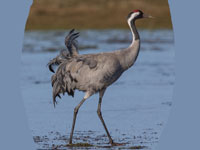


Crane,_Hooded Grus monacha
Description: The hooded crane has a dark gray body with a white upper neck and a white head with bare red skin above the eye.
Range: Asia.
Habitat: Wetlands, bogs, grasslands, agricultural land, rice paddies, river edges, lakesides, and marshes.
Conservation status: The hooded crane is vulnerable due to habitat destruction.
Image by: 1) TomoSuke214 - Japan 2) Viktor_Kravtchenko 3) Scorpions and Centaurs - Denver Zoo 4) Marcel Holyoak - JapanRange: Asia.
Habitat: Wetlands, bogs, grasslands, agricultural land, rice paddies, river edges, lakesides, and marshes.
Conservation status: The hooded crane is vulnerable due to habitat destruction.
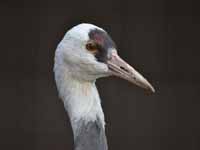

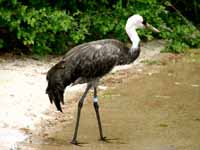

Crane,_Red-crowned Grus japonensis
Description: The red-crowned crane has mainly white plumage with a black neck and tail and a bare-skinned red crown. White stripes extend from the eye down the nape. The male has black cheeks, and the female has gray cheeks.
Range: Asia.
Habitat: Wetlands, marshes, rivers, rice paddies, and mudflats.
Conservation status: The red-crowned crane is endangered due to habitat destruction, poaching, poisoning, and human disturbance.
Image by: 1) Mike Souza 2) KCZooFan 3) KongFu_Wang 4) LonelyShrimp - ChinaRange: Asia.
Habitat: Wetlands, marshes, rivers, rice paddies, and mudflats.
Conservation status: The red-crowned crane is endangered due to habitat destruction, poaching, poisoning, and human disturbance.




Crane,_Sandhill Grus canadensis
Description: The sandhill crane has mainly gray plumage with a red forehead, white cheeks, and a long dark bill. During the breeding season, the gray in its plumage has a rusty tinge.
Range: North America and Asia.
Habitat: Wetlands, marshes, bogs, prairies, wet meadows, croplands, pasturelands, and grasslands.
Conservation status: Least concern.
Image by: 1) Dick Daniels - Virginia 2) Dick - Virginia 3, 4) Dick - Florida Range: North America and Asia.
Habitat: Wetlands, marshes, bogs, prairies, wet meadows, croplands, pasturelands, and grasslands.
Conservation status: Least concern.




Crane,_Sarus Grus antigone
Description: The sarus crane has mainly gray plumage with black wingtips, a red head, and a gray crown. It has gray ear patches, a black and red upper neck. It is similar to the brolga, but the latter does not have a red neck.
Range: Asia and Australia.
Habitat: Shallow wetlands, marshes, ponds, rice paddies, wet grasslands, and agricultural areas.
Conservation status: The sarus crane is vulnerable due to habitat destruction, poaching, and pollution.
Image by: 1) Koshy_Koshy 2,
3,
4) JM Garg - India Range: Asia and Australia.
Habitat: Shallow wetlands, marshes, ponds, rice paddies, wet grasslands, and agricultural areas.
Conservation status: The sarus crane is vulnerable due to habitat destruction, poaching, and pollution.


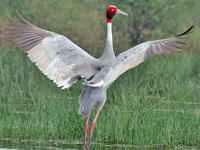

Crane,_Siberian also Siberian White Crane Grus leucogeranus
Description: The Siberian crane has white plumage with black wingtips and bare red skin on the forehead and face.
Range: Asia.
Habitat: Wetlands, marshes, and lakesides.
Conservation status: The Siberian crane is critically endangered due to habitat destruction, poaching, poisoning, and pollution.
Image by: 1) Hiyashi_Haka 2) BS Thurner Hof 3) Tomosuke214 4) Blake Matheson - ChinaRange: Asia.
Habitat: Wetlands, marshes, and lakesides.
Conservation status: The Siberian crane is critically endangered due to habitat destruction, poaching, poisoning, and pollution.
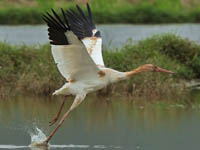



Crane,_White-naped Grus vipio
Description: The white-naped crane has a gray body with a white nape and head. It has red facial skin, gray ear patches, and black coverts near the base of the bill.
Range: Asia.
Habitat: Wetlands, grassy marshes, reedbeds, and croplands.
Conservation status: They are vulnerable due to habitat destruction and poaching.
Image by: 1) Bakker ,2) Sandy Cole - Central Zoo of Nepal 3, 4) Spaceaero2 Range: Asia.
Habitat: Wetlands, grassy marshes, reedbeds, and croplands.
Conservation status: They are vulnerable due to habitat destruction and poaching.




Crane,_Whooping Grus americana
Description: The whooping crane has white plumage with a red crown and black wingtips.
Range: North America.
Habitat: Forests, moors, ponds, wetlands, croplands, and coastal environments (during winter).
Conservation status: The whooping crane is critically endangered due to habitat destruction, collision with power lines, illegal shooting, and human disturbance.
Image by: 1) John Noll, USDA- Texas Range: North America.
Habitat: Forests, moors, ponds, wetlands, croplands, and coastal environments (during winter).
Conservation status: The whooping crane is critically endangered due to habitat destruction, collision with power lines, illegal shooting, and human disturbance.
2) Lyn Anynom 3) Steve Gifford, USFWD - Indiana 4) Wisconsin Dept. of Nat. Resources
4) From Wisconsin to Florida to introduce into wild




